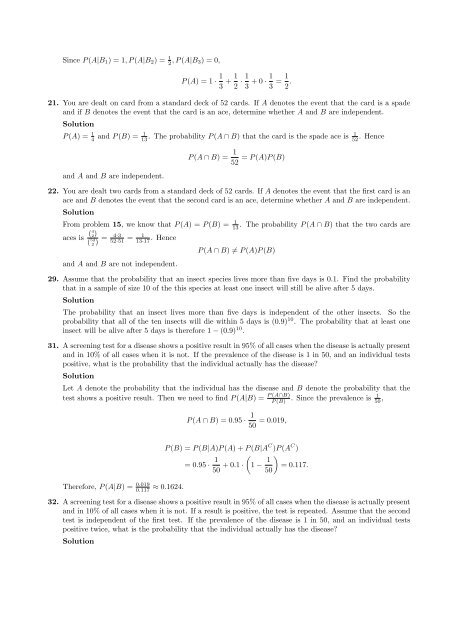Math 3C Homework 3 Solutions
Math 3C Homework 3 Solutions
Math 3C Homework 3 Solutions
Create successful ePaper yourself
Turn your PDF publications into a flip-book with our unique Google optimized e-Paper software.
Since P (A|B1) = 1, P (A|B2) = 1<br />
2 , P (A|B3) = 0,<br />
P (A) = 1 · 1 1 1 1 1<br />
+ · + 0 · =<br />
3 2 3 3 2 .<br />
21. You are dealt on card from a standard deck of 52 cards. If A denotes the event that the card is a spade<br />
and if B denotes the event that the card is an ace, determine whether A and B are independent.<br />
Solution<br />
P (A) = 1<br />
4<br />
1<br />
1<br />
and P (B) = 13 . The probability P (A ∩ B) that the card is the spade ace is 52 . Hence<br />
and A and B are independent.<br />
P (A ∩ B) = 1<br />
= P (A)P (B)<br />
52<br />
22. You are dealt two cards from a standard deck of 52 cards. If A denotes the event that the first card is an<br />
ace and B denotes the event that the second card is an ace, determine whether A and B are independent.<br />
Solution<br />
From problem 15, we know that P (A) = P (B) = 1<br />
13<br />
aces is (4 2) 4·3 1<br />
= 52·51 = 13·17 . Hence<br />
( 52<br />
2 )<br />
and A and B are not independent.<br />
P (A ∩ B) = P (A)P (B)<br />
. The probability P (A ∩ B) that the two cards are<br />
29. Assume that the probability that an insect species lives more than five days is 0.1. Find the probability<br />
that in a sample of size 10 of the this species at least one insect will still be alive after 5 days.<br />
Solution<br />
The probability that an insect lives more than five days is independent of the other insects. So the<br />
probability that all of the ten insects will die within 5 days is (0.9) 10 . The probability that at least one<br />
insect will be alive after 5 days is therefore 1 − (0.9) 10 .<br />
31. A screening test for a disease shows a positive result in 95% of all cases when the disease is actually present<br />
and in 10% of all cases when it is not. If the prevalence of the disease is 1 in 50, and an individual tests<br />
positive, what is the probability that the individual actually has the disease?<br />
Solution<br />
Let A denote the probability that the individual has the disease and B denote the probability that the<br />
test shows a positive result. Then we need to find P (A|B) =<br />
Therefore, P (A|B) = 0.019<br />
0.117 ≈ 0.1624.<br />
P (A ∩ B) = 0.95 · 1<br />
= 0.019,<br />
50<br />
P (B) = P (B|A)P (A) + P (B|A C )P (A C )<br />
= 0.95 · 1<br />
+ 0.1 ·<br />
50<br />
<br />
1 − 1<br />
50<br />
P (A∩B)<br />
P (B) . Since the prevalence is 1<br />
50 ,<br />
<br />
= 0.117.<br />
32. A screening test for a disease shows a positive result in 95% of all cases when the disease is actually present<br />
and in 10% of all cases when it is not. If a result is positive, the test is repeated. Assume that the second<br />
test is independent of the first test. If the prevalence of the disease is 1 in 50, and an individual tests<br />
positive twice, what is the probability that the individual actually has the disease?<br />
Solution
















